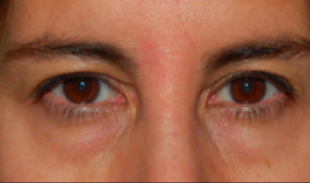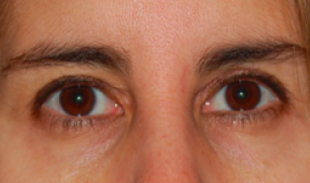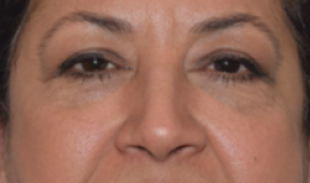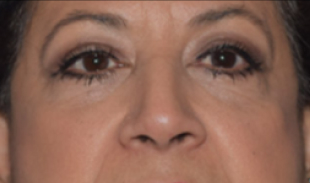Eyelid Lift
Blepharoplasty (eyelid surgery or an eyelid lift) aims to improve the appearance of the aging upper and/or lower eyelids.
Oftentimes, signs of aging, such as excess skin and bulging fat pockets, can contribute to a more tired or a more harsh appearance of the face. Blepharoplasty procedures can greatly improve these indications of aging and result in a more rested, youthful, and softer appearance.
Learn More About Eyelid Lift
Blepharoplasty is a beneficial procedure for patients with puffiness, drooping, and wrinkles around the eyes. Ideal candidates are generally over the age of 30 and healthy non-smokers. Upper blepharoplasty may also improve the field of vision for patients who experience vision obstruction due to sagging upper eyelids.
Certain medical conditions, such as glaucoma or cardiovascular disease, may affect your eligibility for this procedure. The best way to determine your candidacy for blepharoplasty is a detailed consultation with Dr. Rapaport.
Dr. Rapaport uses the most advanced technique and tailors each procedure to the patient’s specific needs. Patients may choose to have an upper, lower, or combined eyelid lift and may also have the procedure performed simultaneously with a brow lift or facelift.
Upper Eyelid Lift
Upper eyelid surgery is performed primarily to remove the excess or drooping skin that may have formed around the upper eyelids due to aging. Heredity, sun damage, and smoking can also hasten these changes. Younger individuals may also elect to have this procedure done to eliminate puffiness of the eyes from congenital excess fatty tissue deposits.
Upper blepharoplasty surgery can dramatically improve excess skin on the upper eyelid itself (“hooding”). It can also greatly improve puffiness in the inner corner and middle of the upper eyelid caused by herniation (pushing forward) of fat in that area.
Lower Eyelid Lift
While the main problem with the aging upper eyelid is generally excess skin, the main problem with the lower eyelid is generally excess fat or “bags.” The fat surrounding the eyelids diminishes as we age, while the fat that causes the bags does not. Furthermore, the membranes that frequently hold that fat back in youth become more relaxed with age, so fat bulges out more.
The fat in under-eye bags does not diminish with age because it belongs to a different compartment than the superficial fat in the face; it is actually orbital fat, meaning fat that surrounds the eyeball. That is why people often refer to bulging lower eyelid fat as herniated fat. These facts of nature lead to the lower eyelid area becoming increasingly harsh in appearance as many people age, with many seeking nonsurgical and surgical options for improvement.
Reducing the excess fat of the lower eyelid is generally straightforward and can be done either from within the eye (transconjunctival) or from outside the eye (open approach). However, reducing the excess skin in the lower eyelid is an entirely different matter. It is frequently not possible in the aging eyelid to surgically remove significant amounts of excess skin because it may lack the support to tolerate such a removal.
This means that if the excess skin is surgically cut away, the lower lid will become pulled down. This creates an unsightly appearance called “scleral show,” which means seeing the white of the sclera under the pigmented cornea in the lower lid. It can further lead to a phenomenon called ectropion, which is an actual outward turning of the lower lid border. These issues can lead to tearing and significant dry eye problems.
For these reasons, Dr. Rapaport assesses each case individually and will advise whether any lower eyelid skin at all can or should be removed. In some cases, a procedure to improve the support of the lower eyelid is performed during lower eyelid blepharoplasty, and this is called a canthoplasty. This is a tightening of the actual support structure of the lower lid. It is not a simple procedure and will be reviewed in detail if recommended.
In a typical upper eyelid lift, Dr. Rapaport carefully marks the skin to determine the precise amount of excess skin to be removed during the procedure. It is crucial to avoid excessive skin removal to maintain both a natural appearance and a normal function of the upper eyelid in lubricating and protecting the globe (eyeball). The incisions are closed with fine sutures, some of which are to be removed as early as two days postoperatively, thereby minimizing the visibility of any scars.
For eyelid puffiness primarily caused by excess fat, Dr. Rapaport can often remove the fat using a transconjunctival approach. With this approach, the incision is made inside the lower eyelid, and excess fat is either removed or repositioned to achieve an improved lower lid contour.
Since the incision is inside the eyelid, no sutures are required, and there is no visible scar. In cases where patients have excess skin on the lower eyelid, Dr. Rapaport will choose to make the incision in an inconspicuous site along the lash line and smile creases of the lower lid. Excess fat and skin are then trimmed away, and the incision is closed with fine sutures.
Anesthesia
Dr. Rapaport can readily perform upper eyelid blepharoplasty under local anesthesia. This is done frequently with oral pre-medication using a pill such as Ativan to help with relaxation.
Most patients still prefer IV sedation. In this situation, the patient essentially has no memory of the procedure, but the anesthesia is minimally invasive, with the patient breathing on his/her own and having a very rapid recovery. Lower eyelid blepharoplasty is almost always performed with IV sedation.
For the first night after blepharoplasty, it is important to rest with the head elevated about 30 degrees. Cold compresses should be applied intermittently for the first week. It is also important to avoid straining or bending over for that first week.
Sutures, if they are used, are removed on or around the second and fifth days after surgery. Patients can return to non-straining activities within two days, but many will take five to seven days off work because of the bruising and swelling. Dr. Rapaport typically allows makeup to be applied one week after blepharoplasty.
Once swelling and bruising fade, patients can see a smoother, rejuvenated eye area. The final results of blepharoplasty are visible in a few months when all residual swelling subsides. Thanks to Dr. Rapaport’s skilled technique, there should be no visible scarring.
Blepharoplasty has permanent results. No surgery can stop the aging process, so the skin around the eyes will continue to age over time, but the individual will still look younger than they would have without an eyelid lift. Typically, optimal results from eyelid surgery last several years. Patients rarely need to have a lower eyelid lift repeated. After several years, another upper blepharoplasty may be necessary to maintain the rejuvenated appearance.
Take the Next Step
Every patient’s transformation journey at Rapaport Plastic Surgery begins with a detailed consultation with Dr. Rapaport. To learn more about blepharoplasty and determine if it’s the right choice for you, fill out the form below or call us at (212) 249-9955 to schedule an appointment. Our team is dedicated to providing the best plastic surgery NYC has to offer.
Ready to book a consultation or treatment? Just click the Book Now button below to schedule online.




